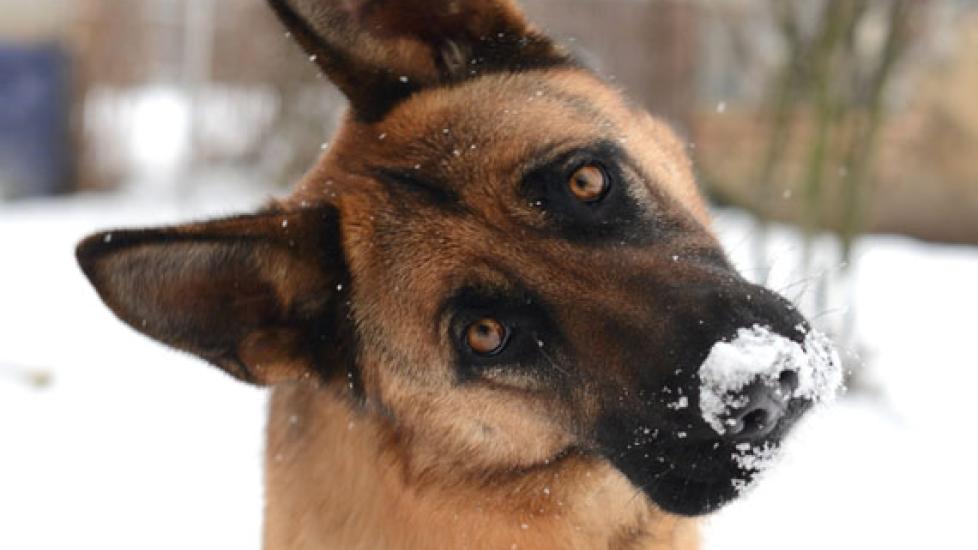How Much Should You Feed Your Dog in Fall and Winter?
Fall is here and winter is approaching. Do you plan to feed your dog the same amount of food as you did this spring and summer? Why? Do you plan to feed the same food? Why? Is your dog as active in the winter months when the temperatures are low and the daylight limited? Is your dog housed outdoors in the winter cold?
Why are these questions important? Dogs need the same seasonal adjustments in their food amounts as we do with seasonal changes. If housed outdoors during the winter, they may also need a different food.
How Cold Temperatures Affect Weight
As temperatures fall, owners are less inclined to exercise their dogs due to their own discomfort in the colder weather. Less exercise means less calorie expenditure. When dogs are expending fewer calories they need less dietary calories and less food. Continuing to feed the same amount of food will result in “winter weight gain” that is unhealthy.
But what about the dog that is housed outdoors during the cold winter months? A key biological imperative of all animals and humans is to maintain a constant core body temperature. Shivering is a means of doing that. But shivering uses large amount of calories. Even non-shivering calorie expenditure increases in the cold. Fat deposits and fur density help insulate and decrease the calorie expenditure of shivering. Also, active animals and those acclimatized to the cold are better protected from the bitterness of cold.
Studies suggest that dogs subject to low temperature exposure need two to three times the normal calories as they need at a more moderate temperature. The increase in calories leads to more fat accumulation and insulation and decreases or compensates for the amount of calorie loss from shivering and non-shivering. Without the extra calories these pets actually lose weight.
Pets subjected to cold also have an altered metabolism. They use fat preferentially to glucose for metabolism. Dogs housed outside in the winter need more dietary fat. This may mean changing from their present dog food to a food higher in fat.
How Less Daylight Affects Weight
Decreasing daylight means less opportunity to exercise and has the same effect as lowered temperatures. Owners are more reluctant to provide the same level of exercise as when there was more daylight. Less exercise means less calorie expenditure. The quantity of food needs to be decreased.
But the shortening of daylight hours causes other change in your dog’s metabolism. Shorter days signal to the dog brain that winter is coming. This sets off hormonal changes to slow metabolism and conserve calorie expenditure. These changes also promote the deposition of fat. This phenomenon is a result of a genetic adaptation called the “thrifty gene.” The thrifty gene prepares the dog for the harsh winter and allows for normal performance in harsh conditions.
For dogs housed inside, this genetic adaptation is disadvantageous to their health. Inside dogs are not subject to the harshness of winter. A decreased metabolism will mean they gain weight if fed the same as other times of the year. Dogs protected from the harshness of winter need less food to compensate for this hormonal metabolic change.
How to Feed Dogs During the Winter
Dogs (and cats) should be fed to their Body Condition Score, or BCS,year around. The BCS is an observational assessment of a pet’s fitness. The system has been proven to correlate with the most sophisticated X-ray technology for determining the percent body fat of pets. A dog or cat should be fed to maintain a perfect 4-5/9 BCS. These dogs have a nice hour-glass waist line when looking from above, a tight tummy tuck when looking form the side, and ribs that cannot be seen but can be felt. Dogs that are 1-3/9 are too thin and those 6-9/ are too heavy.
The recommendations that follow for feeding dogs during seasonal changes only apply to fit dogs. Any dog or cat with a BCS equal to or greater than 6/9 needs a supervised weight loss program no matter what the season.
If your dog progresses from a 4-5/9 to a 6/9 during the winter, then reduce the amount you feed by 10 percent. Continue the reduction in 10 percent increments until your dog is back to a 4-5/9. If your dog slips to a 3/9 then increase feed in 10 precent increments until he/she is back to a 4-5/9.
Make the appropriate changes and feed to maintain that perfect BCS. My motto is “score a four and live some more” and is based on research that has confirmed that dogs kept in a fit condition their whole life live almost two years longer than their overweight littermates. Embrace changes in seasons. Feed your dog differently as needed. Use the BCS.

Dr. Ken Tudor
Image: Marcel Jancovic / Shutterstock
